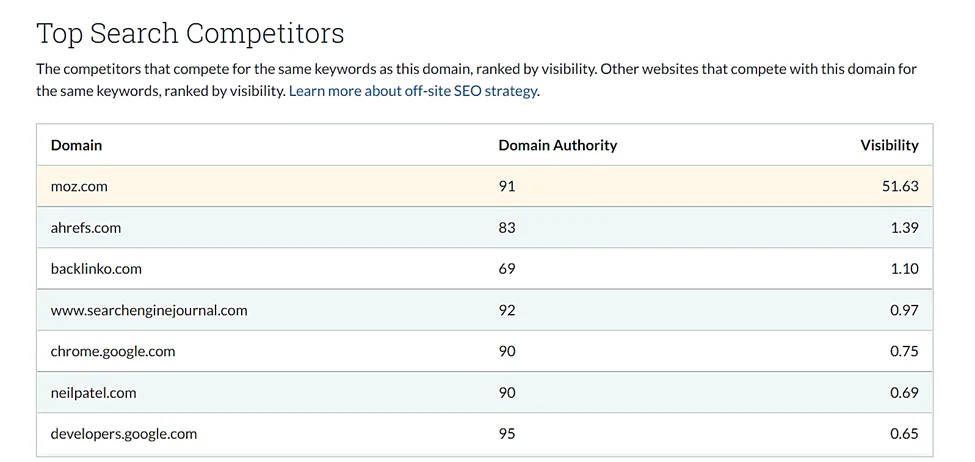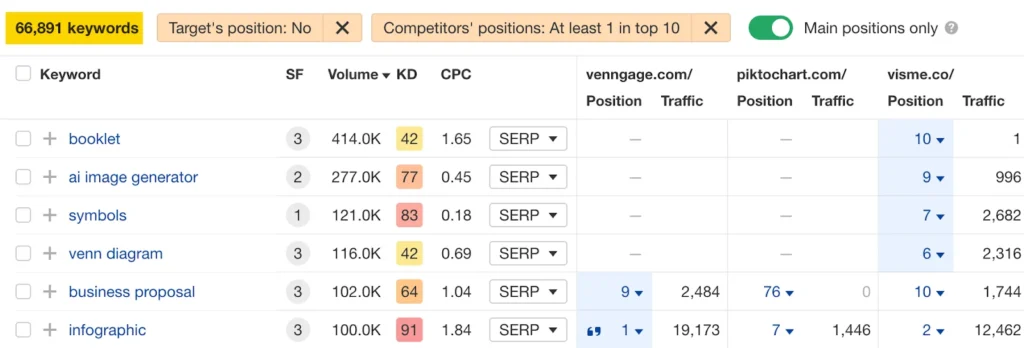In the SEO world, Domain Authority (DA) and Domain Rating (DR) are two essential metrics. They help evaluate a website’s strength and credibility. However, many people use them interchangeably despite their differences.
Although they have similarities, DA and DR are distinct tools developed by different companies with unique calculation methods and purposes.
This blog will explore the key differences between Domain Authority and Domain Rating and delve into how they work.
It will also provide actionable tips for using and checking these metrics effectively.
Table of Contents
Domain Authority vs. Domain Rating: Are They the Same?
When discussing SEO metrics, Domain Authority and Domain Rating often come up as comparable indicators.
Both aim to evaluate a website’s strength. However, they differ significantly in their calculation methods, focus areas, and intended uses.
Similarities Between DA and DR
- Both are measured on a 1–100 scale, with higher scores indicating stronger domains.
- Both are used to assess a website’s authority and its ability to rank in search engine results.
- Both rely heavily on backlinks as a primary factor in their calculations.
Key Differences Between DA and DR
Despite these similarities, the differences between the two metrics are why they shouldn’t be used interchangeably. Let’s list them down-
Purpose
- DA (created by Moz) predicts a site’s ability to rank on search engines based on multiple factors.
- DR (developed by Ahrefs) exclusively evaluates the strength of a website’s backlink profile.
Calculation Factors
- DA considers linking root domains, backlink quality, and other Moz-proprietary algorithms.
- DR focuses solely on the quantity and quality of referring domains linking to the site.
Scope of Analysis
- DA evaluates how a site competes in the overall search engine landscape.
- DR emphasizes link-building potential and link profile health.
Type of Metric
- DA is a relative metric that compares your site with competitors.
- DR is an absolute metric that only focuses on your site’s backlink profile.
What Is Domain Authority (DA)?
Domain Authority (DA) is a metric developed by Moz to predict how well a website is likely to rank in search engine results.
Scored on a 1–100 scale, a higher DA indicates a stronger likelihood of ranking for competitive keywords.
How Is Domain Authority Calculated?
Moz uses a variety of factors to calculate DA, including-
- Linking Root Domains: The number of unique domains linking to a website. A diverse backlink profile strengthens DA.
- Link Quality: Backlinks from high-authority and relevant websites carry more weight than low-quality sources.
- Search Engine Ranking Potential: DA considers how well a website competes in search engine results compared to other sites in the same niche.
Moz uses machine learning models to refine the DA metric, meaning it evolves over time based on changes in search engine algorithms and data.
For example, this is the number of links indexed, keywords, and pages discovered, as promised by Moz, to determine the DA of a site-

Why Does Domain Authority Matter?
- Competitive Analysis: DA helps you benchmark your site against competitors in your industry.
- Backlink Strategy: Higher DA indicates a stronger backlink profile, which improves the effectiveness of your SEO efforts.
- Content Planning: Sites with higher DA are more likely to rank for competitive keywords, guiding your content strategy.

Limitations of Domain Authority
- Not a Google Metric: DA is not a ranking factor used by Google; it’s a third-party metric developed by Moz.
- Overemphasis on Backlinks: While backlinks are critical, DA does not account for other factors like content quality or user experience.
Practical Applications of DA
- Evaluate Backlink Opportunities: Prioritize link-building efforts with high-DA websites for maximum SEO benefit.
- Track Progress: Regularly monitor your DA to gauge the success of your SEO campaigns.
- Compare Competitors: Use DA to identify competitors’ strengths and weaknesses in the search landscape.
What Is Domain Rating (DR)?
Domain Rating (DR) is an SEO metric developed by Ahrefs that measures the strength of a website’s backlink profile.
Like Domain Authority (DA), DR is scored on a 0–100 scale. Here, higher scores indicate a stronger and more authoritative backlink profile.
However, DR focuses exclusively on backlinks, making it a specialized tool for assessing a domain’s link-building potential.
How Is Domain Rating Calculated?
Ahrefs calculates DR based on several key factors-
- Referring Domains: The number of unique domains linking to a website. A site with many high-quality referring domains will have a higher DR.
- Backlink Quality: Links from high-authority websites carry more weight than those from low-quality or spammy sites.
- Link Strength Distribution: DR also considers how a site distributes its link strength among the domains it links to. A site that links to fewer domains passes more link equity, boosting DR.
Ahrefs uses a logarithmic scale, meaning moving from a DR of 10 to 20 is easier than from 70 to 80. This makes higher DR scores increasingly challenging to achieve, reflecting true authority.
Why Does Domain Rating Matter?
- Backlink Analysis: DR helps evaluate the quality and strength of a website’s backlink profile, making it an essential metric for link-building campaigns.
- Competitive Research: Comparing DR scores between your site and competitors provides insights into how your link-building strategy stacks up.
- Link-Building Opportunities: High-DR websites are likelier to pass valuable link equity, making them ideal targets for outreach efforts.

Limitations of Domain Rating
- Narrow Focus: DR focuses only on backlinks and doesn’t consider on-page SEO, content quality, or user experience.
- Not a Google Metric: DR is a third-party metric created by Ahrefs and isn’t directly tied to Google’s ranking algorithms.
Practical Applications of DR
- Identify High-Value Backlinks: Use DR to prioritize link-building opportunities with authoritative websites.
- Monitor Link-Building Success: A steady increase in DR indicates an effective backlink strategy.
- Evaluate Competitor Strategies: Analyze competitors’ DR to identify gaps and opportunities in your own backlink profile.
While Domain Rating provides a focused view of backlink profile strength, it works best when combined with other SEO metrics like-
- Organic traffic
- Keyword rankings and,
- Domain Authority
-for a comprehensive understanding of your site’s performance.
How to Check Domain Authority and Domain Rating
Understanding your website’s Domain Authority (DA) and Domain Rating (DR) is critical for evaluating its SEO health. These metrics provide insights into your website’s authority, link-building success, and competitive position.
Checking and monitoring DA and DR regularly will let you identify improvement opportunities and measure the impact of your strategies.
Let’s dive into how you can use tools like Moz and Ahrefs to check these metrics effectively.
How to Check Domain Authority (DA)
Domain Authority is a proprietary metric developed by Moz, and the most reliable way to check it is through Moz’s Link Explorer. Here’s a step-by-step guide-
- Go to Moz Domain Analysis tool, which is Moz’s dedicated tool for analyzing backlink data and DA.
- In the search bar, type your website’s URL (e.g., www.yourlawfirm.com). Click the “Check DA” button to see your site’s Domain Authority.

However, if you get the Moz pro version, you can check other metrics and a detailed report. In that case-
- Once the results load, your Domain Authority score will be prominently displayed. Below the DA, you’ll find additional insights like-
- Linking Root Domains: The number of unique domains linking to your site.
- Inbound Links: A list of specific backlinks your site has earned.
- Top Linking Domains: Sites providing the most valuable backlinks to your domain.
- To gauge your competitive standing, enter the URLs of competitor websites on Moz Competitive Analysis Tool.

This will allow you to benchmark your DA against your competitors, revealing gaps in your backlink strategy.
Other Tools to Check DA
- SERPChecker: Offers a side-by-side comparison of DA for multiple domains in search results.
- SmallSEOTools: A free, beginner-friendly tool for checking DA quickly.
How to Check Domain Rating (DR)
Domain Rating is calculated by Ahrefs, a leading SEO platform known for its robust backlink analysis tools. To check DR, you’ll need access to Ahrefs Site Explorer.
- Visit Ahrefs and log into your account. If you don’t have an account, Ahrefs offers a trial for new users.
- Navigate to the Site Explorer tool, a powerful feature for analyzing website metrics, backlinks, and traffic.
- Enter your website’s URL in the search bar and click the “Search” button. Ahrefs will generate a comprehensive report for your site.

- The DR score is displayed prominently in the overview section. Alongside DR, Ahrefs provides other valuable metrics, such as:
- Referring Domains: The number of unique domains linking to your site.
- Backlink Profile: A detailed list of all backlinks pointing to your site.
- Traffic Data: Insights into organic and referral traffic.
- Use the same process to check DR for competitor websites. Compare their DR, referring domains, and backlink quality to uncover opportunities for improvement.
- However, the best way to do a competitor analysis using Ahrefs is to use their ‘Competitor Analysis’ tool. There, you can type in your and your competitor’s domain URLs.

- Once you click ‘Compare,’ you will see a detailed comparison of each domain’s different metrics.
- Ahrefs allows you to click on individual referring domains to assess their quality and relevance. Use this data to identify high-value link-building opportunities.
Here, you can also check the keywords relevant to your competitors that they are ranking for. These are some good keywords to target.

In case you are wondering how to find your competitor in the first place, you can use the ‘Organic Competitor’ tab on the Site Explorer tool of Ahrefs.

Other Tools to Check DR
- SEMrush: Offers a backlink authority score comparable to DR.
- Ubersuggest: Provides a simplified version of backlink metrics suitable for beginners.
Tips for Using DA and DR Effectively
- Understand the Purpose of Each Metric: Use DA for a broader perspective on your site’s ranking potential and DR to focus on backlink quality and link-building efforts.
- Monitor Regularly: Monitor changes in DA and DR over time to measure the effectiveness of your SEO campaigns.
Sudden drops may indicate lost backlinks or penalties, while consistent growth reflects successful strategies.
- Cross-Reference Metrics: Don’t rely solely on DA or DR. Combine these with other metrics like organic traffic, spam score, and keyword rankings for a holistic SEO analysis.
- Prioritize Quality Over Quantity: Both DA and DR emphasize the importance of high-quality backlinks.
Focus your link-building efforts on authoritative, niche-relevant websites instead of acquiring a high volume of low-value links.
- Leverage Competitive Insights: Use DA and DR to analyze competitors’ strengths and identify gaps in your own strategy.
For instance, if a competitor has a higher DR, examine their backlink sources for potential outreach opportunities.
Which Metric Should You Use?
Domain Authority (DA) and Domain Rating (DR) serve different purposes, so the metric you prioritize depends on your specific SEO goals.
Ideally, both metrics should be used together for a comprehensive analysis.
When to Use DA
DA is beneficial for competitive analysis, helping you understand where your site stands in relation to competitors within your niche.
DA is also valuable for planning your content strategy, as higher DA sites are more likely to rank for competitive keywords.
When to Use DR
If your focus is on link-building, DR is an excellent metric for identifying high-value domains to target for outreach. Use DR to track your progress in acquiring high-quality backlinks over time.
A Balanced Approach
While DA offers a broader view of ranking potential, DR provides a focused assessment of backlink strength. Relying solely on one metric can lead to a skewed understanding of your website’s performance.
Instead, consider using both metrics alongside other SEO indicators like organic traffic and keyword rankings for a well-rounded strategy.
Boost your Domain Authority and Domain Rating with expert help from RankPa. Our tailored SEO services can enhance your backlink strategy and drive measurable results for your website.
Key Takeaways
Domain Authority and Domain Rating are essential metrics for evaluating a website’s strength, but they serve distinct purposes. While DA measures overall ranking potential, DR focuses on backlink quality.
Combining these insights with tools like Moz and Ahrefs will let you maximize your website’s growth potential.
Do note that Google doesn’t use any of these two metrics. Instead, it used to use PageRank.Although, nowadays, Google’s AI crawlers are smart enough to understand the quality of content. They also look at context and intent, usefulness, and repetitiveness of content.


